Sarah Gerdes's Blog, page 7
July 20, 2019
Cesky Krumlov Castle
Following on my piece on the Gardens of Cesky Krumlov, now it’s time to continue the tour of the castle itself, but before I pick up where I left off, I’m going to back track to provide several views of the lead-up to the main entrance.

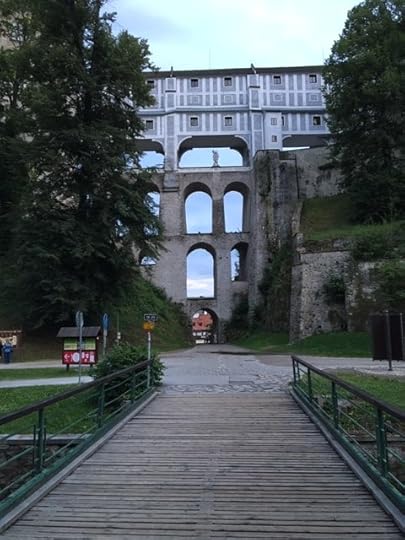
From any direction, you must cross the waterway at some point to reach the castle. This bridge is right in from off the parking area and where we walked. The grand, multi-storied bridges.

Two hillsides? No problem. Let’s just keep creating rooms and hallways.


To the right is the actors areas attached to the theatre, and the left is the staff (seamstress etc)
If you are at the gardens, head to the upper most level (the maze). To the north, you can view the fields beyond, to the south is the main castle area.

The royal lands are still being farmed- this is to the north, just outside the gardens.
That’s the way we went, coming to the castle theatre. The ticket office is a remodeled building, attached to an extended, low-ceiling structure that’s the performer quarters. A lane for pedestrians’ splits that building and another on the left for the staff, wardrobe and such. From here, a visitor has multiple options to tour the inside or explore the open (free) areas on every side of the castle.

One of the side entrances leading to the castle, not the main gate.

One of the back entrances leading to the castle.
A castle-shaking entrance
Batman must have had a bigger impact on me than I’d care to admit because I’m always so completely fascinated with castle entrances. It’s not just the size and ‘grandness’ of the entry if you will, nor is it the number of barriers put in place. It’s also the length and ceilings. Just as one driveway can be printed stone and fifty feet, another can be a mile in length, tree-line with water and lighting effects. Some, such as Hohenschwangau, were both straight then circular roads, leading up and up to the main castle.

The actual carriage house where the horses were prepared and stabled.
In the castle of Cesky Krumlov, the road taken by the former rulers is long, steep, imposing with four different barriers, entirely covered with curved stone ceilings, barred windows providing views to the valley below. On the right (the inner wall) are periodic cell-like rooms with bars. Were these for prisoners begging to get out? What about goods necessary for the road maintenance during the winter, but what was the point of the bars? These questions didn’t get answered on our first visit and weren’t satisfied this time around either.

In case you get lost–and that’s a not hard to do in this expansive set of buildings.
What we remarked on then and now is the sound of the tunnel. We were talking low as we made the walk up, but we could have been shouting for all it echoed. Imagine a team of eight or twelve horses racing through, clanging on the stone, whip cracking. The entire castle might be rumbling from within, and surely the townsfolk below would be alerted the rulers had made it home for the night.

One of the disembarking areas for the carriages–this is the lesser of two areas, but has been updated for outdoor festivals.
With the occupants out of the carriage, the horses were led to one of two horse carriage houses, the first one being the grandest. Life-size replicas of the horses and carriages are within the house, which accomplished the task of allowing us to visualize the magnificence of the experience of those ruling the castle and town.

Even the peepholes have incredible views.
Authentic artists in the castle square
Not all castles have a gift shop for selling products, but if they do, it’s usually overpriced trinkets. Not so here. Eight stalls set up in medieval, square coverings showcase artisans, no two the same. With the exception of two, each were demonstrating their craft as they made products. A weaver worked at his loom, creating a shawl. A jeweler set stones in sterling silver, a woman crushed lavender for her satchels and a glass blower delicately created small objects.
The most impressive was a two-person team of iron work. Pumping a pedal with one foot, a man kept his small fire going as he insert metal, melted it to the right temperature before removing it. His work wasn’t just knives, as we’d seen in the past, but objects useful and not. When we arrived at the area, he was making a cup. The second time, a detailed iron rose, the kind you’d place in a vase. His partner worked behind the counter, adding additional touches to the works, such as leather, beading or an embellishment appropriate for the item.
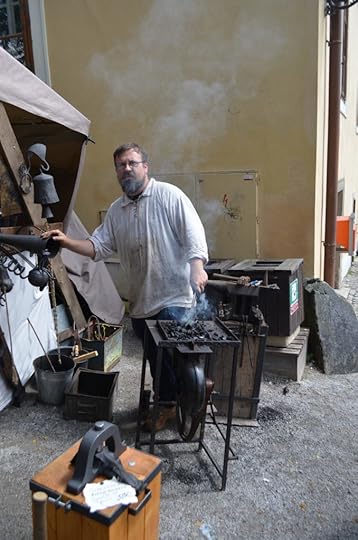
The artisan and his craft.
You can probably tell we got sucked in by the skill of it all, purchasing a sterling silver ring with woven details, a lavender pouch for traveling and a few other unique items as a memory of Cesky Krumlov.

Cesky is interesting, because they offer mini-tour/sections are available for independent payment and viewing. You want to go inside the carriage house? Sure, it’s a little fee. This is another wine cellar, charged a’la cart. Don’t hit your head on the way down.
Two times a charm
Because we arrived in the late evening our first night, we had the chance to explore without crowds. Day two, our visit was about 90 minutes, giving us the rest of the afternoon to wander the town, which was our hope. That’s up next, because skimming the town really does it a disservice.
My favorite part of Cesky Krumlov Castle
The waterway around the castle, the entry and incredible view of the town from most any point. A close second is the town and culinary extravaganza that is the town of Cesky Krumlov.

The castle is long, it connects around the entire curvature of the river below. Photo taken from yet another ledge.
My least favorite part
That the renovation and remodeling required has gone a little cheesy. It’s one thing to resurface a crumbling wall, and most of the time, care is taken to at least try and make the application of paint appear more than five minutes old. The paint here doesn’t really match tone or color, but it’s looks almost cartoonish in more than a few places. We tried our best to overlook it, or at least not take pictures with the faux application in the background.

On the middle-bridge overlooking the town of Cesky Krumlov below.
Recommendation
Even though we are now up to three times to this castle, I know we’ll come again…and again. Perhaps not for the inside tour, but outside absolutely, and the town—always and forever. More on that next.

One of many garden areas for the court modified with atriums, benches and cafes (not pictured).
Feature photo: taken on site
July 19, 2019
The Gardens of Cesky Krumlov Castle
This spectacular town and castle warrant a few different
pieces, starting with the gardens.
“What is Cesky Krumlov and why is it special?” I’d asked a man at the Karlstein Castle during our last visit. He asked if we’d been, I replied no, and he fervently told us that any plans we had for the Republic needed to be altered so we could take it in. He was so passionate, we followed his advice, but only had a few hours to see the castle and town before needing to leave for our next destination. For four years, we looked forward to the time we could return. That day came today.

The first level of the three-level gardens. Wide, pebble lanes with plenty of shaded areas.
Evening arrival
Fortunately for us, we’d arrived around six p.m., the tour
buses were already gone, the grounds largely unoccupied. From our bed and
breakfast, the walk was less than ten minutes, the air cool and a little
sprinkle of rain, but not enough to justify coats.
Taking a right off the street and walking one hundred feet brought us to the moat, bridge and inspiring view of the multi-story (and multi-level walkway) that defines Cesky. Remembering our last visit, we chose a different path up (and my now long-suffering feet feeling the effects of castle steps). While it didn’t lessen the grade of the climb, our entrance was in the castle gardens area, not the courtyard.
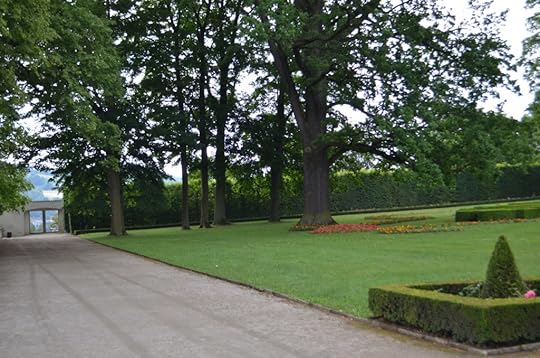
Each level has openings to the main castle areas for easy in and out.
Size and simplicity
One word: wow. This is not the Palace in Brussels, where hundreds of thousand of flowers in perfect order exist. It’s quite the opposite. Cesky Gardens have multiple levels, several larger than football fields but modest in flowers, using color for accents. The focus is on perfectly trimmed hedges and plenty of walk room on several levels. The first is open in the center, with massive trees shading the perimeter. Grand stone steps lead to second level, this one with more flowers, as though the designer was saying: we were starting small, working our way up.

Level two has a bit more color and detail, although the length is the same, the width is much deeper.

View from the top/third level down to the second, giving you an idea of both size and also detailing of the flowers.
After this level is yet a third, and it’s twice as long is it is wide. Standing at the edge gives views of both gardens below, then turn around and it’s a maze! A one-person, wood platform exists for an observer to gave over the maze-hedge, presumably to locate the poor souls lost within.

As I went to load the photo of the maze, I couldn’t find one! I must have completely spaced it, and feel awful.
North and south are entrances, one to the fields beyond, the other to the main castle area. Next up, Cesky Castle proper.
Pension Fialka: the best B & B Nearest Cesky Krumlov Castle
When we were last in Cesky Krumlov, we had an amazing stay in a teeny, tiny room with a queen and twin beds near the castle. The host/owner was awesome, breakfast great and nearby river a bonus. The few downside of that particular pension, (as B & B’s are called in Europe), were lack of air conditioning, the requirement to drive to the castle and find parking. Even so, we wanted to stay there but it was full, so Rog ended up booking us at Pension Fialka.
It’s all about the location
I’m not sure it’s possible to have a better location than Pension Fialka. On a corner, Pension Fialka has full views of the Cesky Krumlov Castle from the view from the bedroom window. The street is busy during the day but dead quiet at night. Yet because Pension Fialka is set back from the road, we didn’t hear the white noise of the cars at all. Out the front gate, across the cross-walk and ten minutes later of walking in the shaded lane and you take a right and there you are.

The town of Cesky Krumlov, a ten minute walk from Pension Fialka, image taking from a bridge at the castle.
Rooms
The B & B offers three units, one of which is made for families as it’s conjoined by a separate door. Two twin beds in one room with its own door, and our room which includes the bathroom. The downside is lack of a second bathroom or tub, but these are minor inconveniences. The beds were firm, pillows flat (and awful, sorry to say), but down-filled comforters compensated. A small sitting area by a flower-filled window basket and knitted throw were lovely touches.


More images are on line, but this shows the bedroom we stayed in. The girls stayed in the adjoining room with twin beds.
Outdoors
We’ve never stayed at a B & B with the diverse areas offered by Pension Fialka. The perimeter is gated, eliminating our fears of privacy and safety. A small swing and slide set is complimented by a more adult pastime of playing hockey. A net, pucks, sticks, slider board for practicing foot movements in your socks drew my husband’s attention to moment we arrived.

For kids and adults alike
A few steps away is a rock path where the owners of (name) created a graduated rockery overlooking the road and to the castle. At the very top of the path is a sitting area with an ever better view, privacy ensured by the curtain of trees.
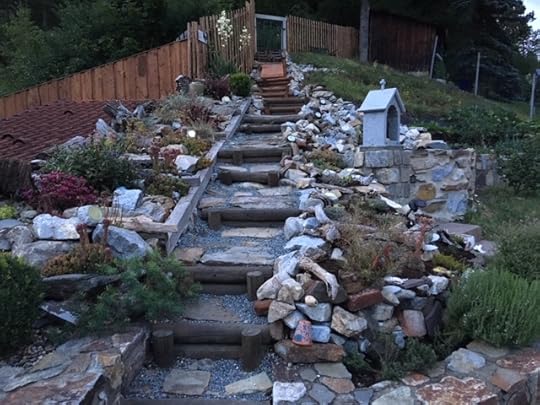
Rockery with sitting areas below and above. What’s not pictured is the covered outdoor eating area with kitchen and traditional pizza oven. A nice touch.
A note on pricing
Four years ago, our three day, two-night cost for lodging was 350 Euro. For that, we had a single room with two bunks and a queen, a light breakfast included. This time around, Pension Fialka was 132 Euro, without a breakfast, but two bedrooms and the other amenities described. For what we paid and received, we were more than pleased.
What I liked most
Gracious rooms, gated home and parking, private terraces, small play area with hockey goal, rockery and covered outdoor eating, and the short walk to the castle. I’d stay here again in a heartbeat.

Private, gated parking, and the short walk to the castle. Safe and quiet road.
What I liked least
It would have been nice to have breakfast, but the home doesn’t accommodate food, nor does it offer a refrigerator.
Feature photo: taken from the opposing side of the street
Fishing & river rafting in the Czech Republic
Outdoor activities isn’t always on the minds of tourists who are dead-set on castle hopping, but when we see an adventure that just can’t be passed up, the Gerdes family slows down, pulls over, accesses the Internet and change on the fly. That’s what happened when we were making the journey from Salzburg, Austria to the Czech Republic, destination the town of Cesky Krumlov and the castle therein.
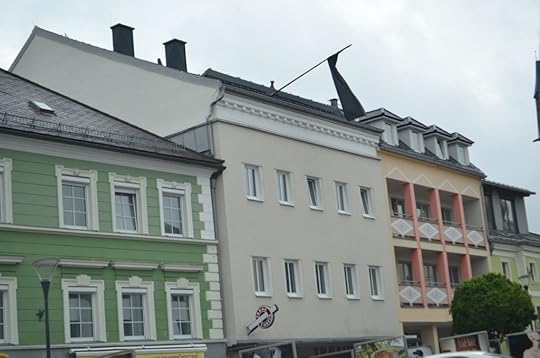
One of my goals through in travel blogging is to give you the visual of being in the car with me (as frightening as that may sound). I’m starting off with a little flavor of the change in scenery as you head out of Salzburg. Modern blends with colorful, styles and vibe just miles from Salzburg.
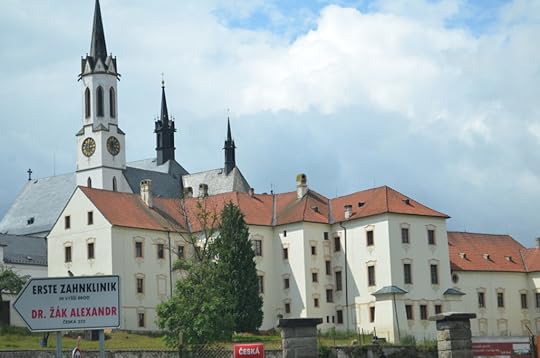
Yet another modest castle in a town thirty minutes outside Salzburg–it didn’t even make the castle list on our GPS. We walked around but had to get on our way.

Three turns down from the castle is a waterway and our first sign of river rafting.
Taking the backroads: tee-pees, eats and reservations
As you’ve read in previous blogs, we tend to go off the A4 when we can afford the time. This was one such occasion, and because the road was curvy and empty, we took our time, Roger slowing or stopping upon request (don’t I wish he’d do that back in Idaho? Hm…) As we crossed from Austria into the Republic, the landscape changed pretty dramatically, and I could have easily been in Oregon, because the trees were densely lush and meandering rivers were rarely out of sight.



Who says Europeans don’t camp? They have this down.
We stopped at one riverside location to grab a bite to each and learned the popularity of river rafting is so high, booking a month in advance is required. Come the middle of July, school is out, family holidays have begun and slots are full. Cancellations rarely occur, so be it rain or shine, people are going to be on those boats, but we weren’t going to be one of them.
Meal eaten, back in the car we went, now admiring the fly fishing and river rafting from the only perspective we’d get, at least on this trip. We’ve mentally added the two activities to our future-state to-do list.
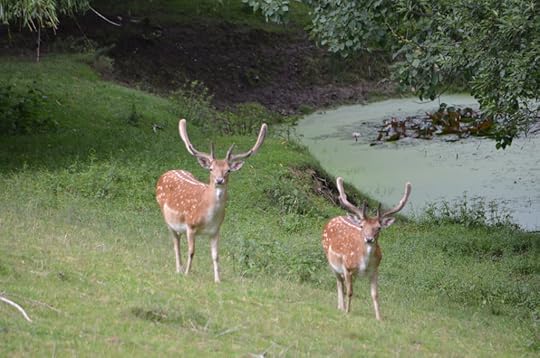
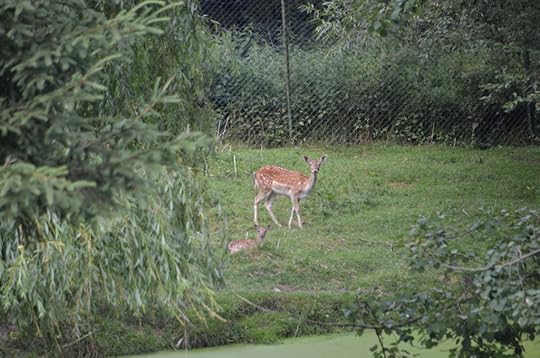
We’d never seen this type of deer-which is hard to see on the upper left. The antlers are flat at the top, like Dumbo’s ears. I tried to get another picture but they ran within an enclosed area. Then I realized they were fenced, the farmer having a pond and several sets newborns nearby.
Then we came to it–the fly fishing streams. Rog pulled over, got out and stared longingly at the scene before him. Two men, wading the stream together, communing with the fish in the most wonderful of ways. All he could do was sigh as I took pictures. Once in the car, we spent at least forty minutes pulling up the best streams in the area (many), local fly shops (many more) and how painful it would be to carry his entire fishing gear on a European trip. Maybe next time, just like the river rafting.

How the locals do it in the Czech Republic
Feature photo: taken about 90 minutes outside Salzburg, in the Czech Republic
July 18, 2019
Hohensalzburg Castle: An unfulfilling checklist castle
What more can be said about Hohensalzburg than is already out there? Not much, in my opinion, other than the brutal review I’m going to provide you of the inside tour, which has been dramatically reduced to five rooms out of hundreds available. It’s not often I want to be Nicole Kidman or someone famous enough to get me access to floors and buildings off limits (not likely to happen in this lifetime), so all I can do is essentially grumble about paying the 30 Euro for our family, getting squished at the top of the tower with bodies, all jostling for the perfect selfie, then down again. On the bright side, we parked and took the ‘locals’ way,’ which made for new views and a quiet experience we enjoyed going up and down, which somewhat countered the lame experience in the middle.
Join me on this, our second and what is likely to be our last trip to Hohensalzburg.



Parking, right downtown in the locals’ area, the backside of the castle. The path is behind homes that lead to the castle-the occupants more than happy to chit chat as they water their beautiful gardens.
The road up and grounds
Neither have changed for four years ago. You can ride the tram up, saving yourself approximately 3,000 steps up, or you can take the leisurely route, which is longer, but in the shade and completely deserted. We encountered 4 other walks besides ourselves, two couples, both of whom stopped to grab a bite to eat on the bench and smooch.



Where the homes stop, this open grassland with bike/walking paths begin. A large home in the distance (UL), the start of the path to the castle (UR) and the four-corners path connecting multiple blocks.
Both tram and step walk are at the base of the castle; the steps are what we did on our first visit. This time, we parked on what I’d call the backside of the castle. It’s on the southwestern side, street parking for 4.50 Euro. The streets are quaint, full of locals, the paths to the castle occupied with families going through the parks. One right at an almost hidden sign lets you know this is it—the way up.
The trail up is paved and well lit, benches spread along the way. Since it’s not the main entrance, it’s quiet, offering plenty of stopping points to take photos. Nearly at the top, a view one can’t see from the front appears, which is an armory.


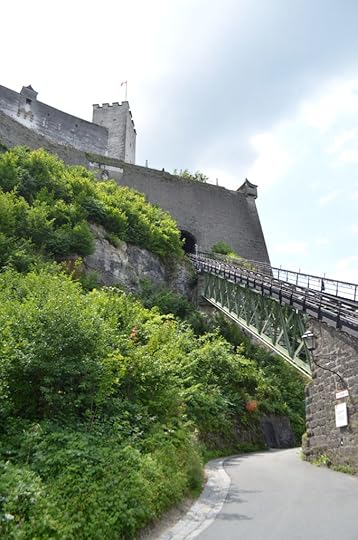
Seriously love the homes at the base of the castle (UL), the final walking rise to the castle (UR) and the tram in castle neither steps or path are your style.
The entrance and free areas
We beat the throng of visitors, arriving at 10:30 a.m. As we
looked down the hill, bus after bus was dropping of streams of people who went
single file to the steps. We were glad to already be at the top. The main
courtyard and restaurants haven’t changed, and I will say my preference is the
eatery on the second-floor landing which overlooks the valley.
Even though we’d seen the inner and outer courtyards, we walked in and around again, stopping to purchase our tickets for the tour. As we waited, we were bummed out to see the plethora of dogs that were on leash, but defecated all around the courtyard. While some castles have allowed dogs in the main courtyard area, few give dogs the general run of the place. This one does—and good for the owners, (we are massive dog lovers and love them). But seriously, responsible dog owners pick up the pooh, but not here. We were dismayed to be walking behind several who just dropped and walked—my phrase for the owner wasn’t going to bother and pick it up. What has happened in the last few years?



One tall set of blocks (UL), the first of many gated entries (UR) and my favorite–four different defensive entries, each another barrier to an invading force. What you can’t see is that each gate is an 18 inch thick rock–the doors have been removed.
The unguided tour
Our bad experience started at just after the ticketing desk. We paid, stood in line to receive the translation device, only to be told we’d have to wait for those in English, which wasn’t a big deal, but they had a hundred just sitting there. Worse, the man set “Get going,” as we waited for one to be cleaned and provided to us.
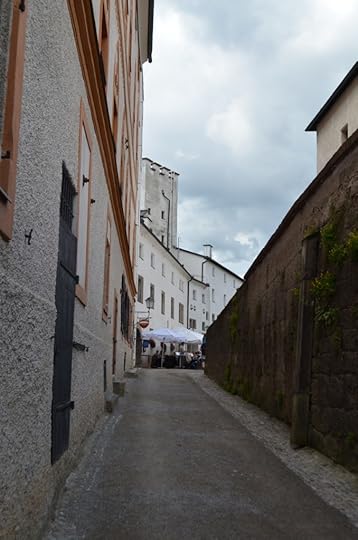

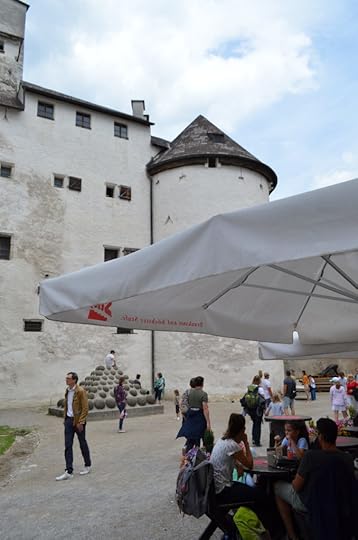
The last stretch to the inner courtyard (UL), a view from above (UR) and the main courtyard, unchanged from our last visit.
We just stared at him. Go where, exactly? One foot to the left so others receiving the French version?
Translators in hand, we went to the first room, the most interesting. It was a room with replicas of the cardinals who oversaw construction of Hohenzollern, accompanied by miniature models of the castle at various points in time. After that, we visited what would have been the salt room, for preserving foods. Then a long corridor, and a peek into the Organ room, housing the “Bull organ. The clergy ruler would have the organ play 3 notes alerting the townsfolks it was time to rise and get to work, and again in the evening, when it was bedtime. Talk about ruling the day.

It was interesting seeing the models representing each stage of completion over the hundreds of years–this is a great example of old meeting new(er).
The downside of this of this piece of history was the cramped 3-foot space where everyone fought to take pictures and keeping their ground while the throng behind us were pushing forward, trying to keep up with the auditory tour guide.

The first room of the tour, with rulers and to scale replicas of the castle at different points in time.
After that, we walked down a long corridor and into the torture chamber. That was more bark than bite, because our virtual tour guide said the room wasn’t actually used for torture, but to display the weapons to put fear in to the prisoners, who were actually held in a room below (not for display).

The pseudo torture chamber– the stones have been resurfaced and painted (poorly) but at least the grate to the left and below my daughter appears authentic.
A few pictures and off we were led to the highest point of the castle. Three flights of narrow stairs for the crowds going up and down, and then you arrive. A square area of stone, providing 360-degree views and in the center, a wooden platform (now reinforced with stone and metal). This can’t be larger than a 15×15 space, if that, including the stairs. Shoving, pushing, self-driven crazies. No time to really enjoy the spectacular prospect of Salzburg below.

Was it worth getting scrunched at the top of the platform? The juries out. I like Roger’s drone videos better.
I was so annoyed, me and the girls looked around, took it in, then got out of the madness. Rog fought his way up to the top, took a pic of us below and called it a day, vowing to get better shots with his drone, which is now up on my Instagram account.

A view on the back that never gets seen if you enter from the front.
Whew. It’s over. Time to eat
After that hour of our life, we were hungry and stopped at the Stocker which we’d seen while parking. The meal we ate made up for the latent grumpiness we experienced at the castle. Over amazing cold shrimp and cucumber salad, pork roast and schnitzel, we analyzed what went wrong.
Unregulated tours for starters, trying to pump as many
people through as fast as possible was the culprit. Unlike Hohenschwangau,
where the tour guide walked us our group of 10 through each room in the entire
castle, and even the larger Hohenzollern
Castle, which is infinitely larger, even there, the personal tour guide
took our group of 12 through multiple rooms. Each tour was detailed, fulfilling,
personal and guess what? The exact same price! Even the more visited Neuschwanstein
Castle has a tour guide, granted, with 60 people, but at least that one is
longer, detailed and fulfilling.
We get it. Castle tourism is a business, and Salzburg is a convenient destination outside Vienna. Mozart’s house is a draw, and many day trip visitors are trying to get both Mozart and Hohensalzburg in at the same time. But to those of us who desire a deeper experience, it’s pretty clear that only fame or a whole lot more money than we possess is going to fulfill that dream, at least with Hohenzollern.
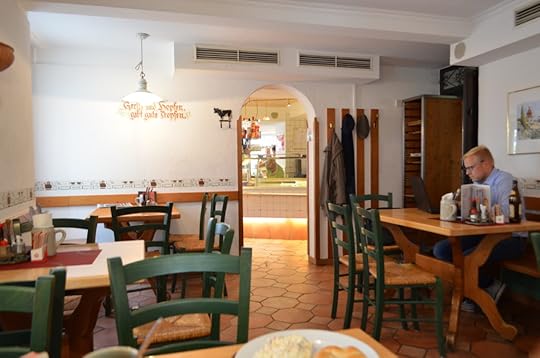


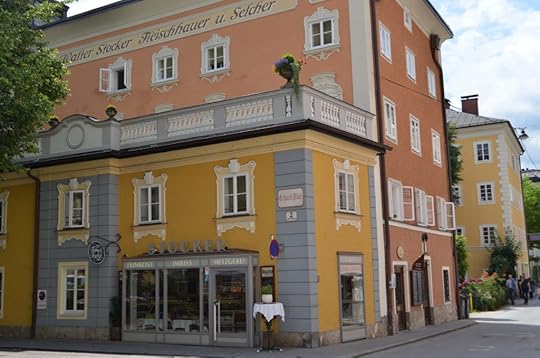
The best part of the visit was the food afterward- or am I being too harsh? Okay, maybe a little, but the food at Stocker is really to die for.
What I liked
The grounds are lovely, and the back path to the castle calm and easy. I also must call out one new room we found which was free and unique–it’s the puppet room. These are life size recreation of puppets that kept the rulers happy. These are shown in a cave-like area within the castle.
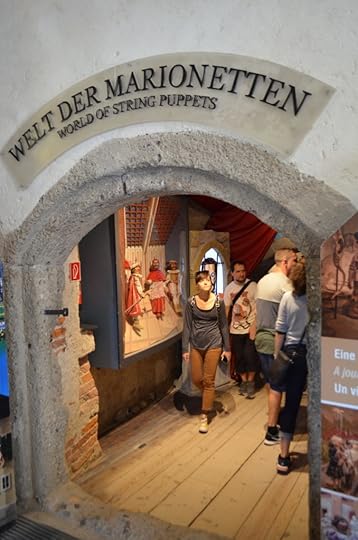

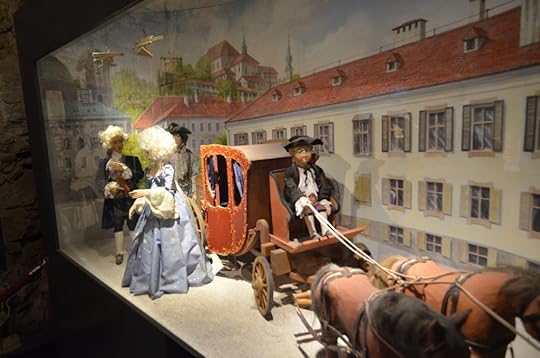
The marionette area was pretty cool in it’s own batcave area.
The town below—be sure to go on the locals side—offers incredible food and shops.
What I didn’t
See the paragraphs above. Too many people. Touristy and unfulfilling.
Recommendation
Even with our disappointment, I’d suggest you go at least once to see the grounds and explore the area. If you are early in the season and have twenty minutes to spare, sure, do the tour. You’ve made it all that way. The best thing to do is set your expectations accordingly. Otherwise, save your money for a castle where you can have an incredibly rewarding experience that you’ll remember the rest of your life, and for all the right reasons.
Feature photo: taken from the perch atop the Hohensalzburg, and not with a selfie stick!
Hotel Turnerwirt in Salzburg, Austria
To this point, we’ve stayed at four apartments, a hotel, a villa and two bed and breakfasts. We have a few more countries and accommodations to go, but I’m receiving quite a few DM’s on places we’ve rented, the logic and pricing. At the end of the journey, I’m planning on a roundup of lodging, but in the rush of our trip, can only write full reviews on places as they deserve it. In this case, I’m writing about a boutique hotel we’ve been staying at in Salzburg, The Hotel Turnerwirt.
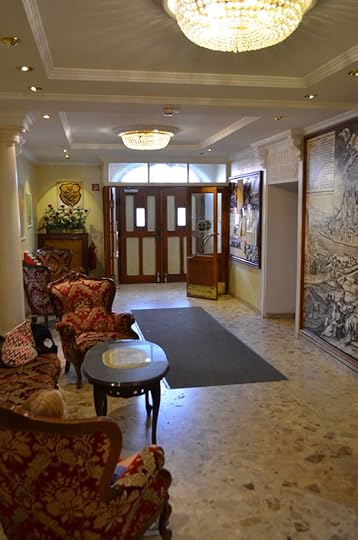
The lobby shot, old Austrian charm with modern convenience.
Why a “boutique” hotel”
As a matter of policy, we don’t stay in large hotels on
overseas trips. The local flavor is what we want, and this is better found with
apartments, homes or B & Bs, but we’ve not had good luck with what is
called a boutique. We think that’s a euphemism for odd; like the place can’t
determine if it’s really a B & B, which means a more homey feel, but doesn’t
live up to the services or amenities offered by a large facility. Since “somewhere-in-the-middle”
has never really worked for me, we’ve avoided boutiques altoghter.
Enter Hotel Turnerwirt. We fell into this hotel because in Salzburg, rental units of any kind were impossible to come by, even before adding our criteria of parking, air conditioning and helpful things like a washer/dryer. For our timeframe, nothing was to be had, so we had a choice of larger or boutique hotels, and we chose the latter. We also desired a hotel within driving distance to Hohensalzburg, which this is–about five minutes. It’s along the bus line route as well, which comes frequently.

A helpful map of historical Salzburg, Austria in the hotel foyer.
Hotel Turnerwirt
This is a boutique because it’s a traditionally built set of structures operating in the Austrian style of service, which means food service on the bottom floor, a game room for children, reading room for adults, a garden area outdoors and another building for spa treatments. Inside the main structure are wide staircases but narrow hallways, one-room “apartments” versus rooms, which define a family living experience. Situated on a corner facing the mountains, streams on either side require guests to cross one bridge to park, and another bridge to reach the hotel. It’s rather romantic.
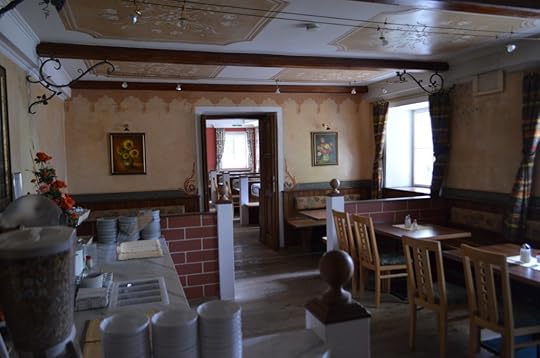
The dining room where morning breakfast is served.
The breakfast (not included) serves a traditional Austrian
breakfast of cold-cuts, cheeses, breads, musli (granola) and poached eggs.
The convenience to excellent restaurants translates to a 5-10 minute walk in any direction, our favorite being Pizzeria gausthaus Schwaben, down the road and across the bridge. Hip, elegant and underpriced as far as we were concerned. Excellent atmosphere, just know the smoking shop right next door can draft more strongly as the evening wears on.



As usual, we were the early family diners. Nearly every table had a ‘reserved’ card when we arrived, and by the time we left, it was packed.



Schnitzel pre mushroom sauce (UL), fettucini carbonara (UR) and us girls
What I liked most about Hotel Turnerwirt
The location, local flavor and uber-helpful staff. Can’t ask for a better combination of those three elements.
What I liked least
The noise in the morning was pretty brutal. I’m not used to thin(er) walls and full families making a racket. Parking was also a bit tricky when we showed up after 7, but we improvised along the walls and made it work. Compared to most B & Bs, or even hotels, the $20Euro per person for the continental breakfast was a bit on the steep side, so we passed after the first morning.
Feature photo: from the Hotel Turnerwirt website
Tyrolean Alps, Innsbruck and Swarovski Headquarters
Sometimes, taking the scenic route reveals the most interesting of destinations. As we traveled from Italy to Austria, we’d inadvertently requested the shortest route in distance, not in terms of time to our final destination of Salzburg. We didn’t realize that meant up and over the hills of Innsbruck, the largest city in the Tyrol province of Austria, and the countries fifth largest. We’d already rounded a curve coming down the mountain and there it was, looming in the distance. Despite the rain, we jumped out to get the best view of the Bergisel Ski Jump Tower. The futuristic tower has hosted two Olympics and many international ski jump competitions.

Summer is road construction time, and that includes multiple bridges. This is right outside Innsbruck.
We missed our window to go up in the tower and have a meal, worried that we’d miss our check in time in Salzburg, so on we went, having no idea the A4 would have saved us about an hour of driving. It was good luck, however, because while our road paralleled the major highway, we saw all sorts of global manufacturing headquarters and outlets we’d never have seen from the road.

Because the Tyrolean Alps sit high, even when descending town into the valley where Innsbrook is located, you get an idea of the massive size of the Bergisel ski jump. This photo was taken just off the road.
From pharmaceutical companies to high-end ski wear such as Bogner
(oh! But it was closed!!), our favorite was the Swarovski
corporate headquarters. We missed several of the attractions by minutes,
but were able to see the grounds, the carousels, the expansive play areas for
children, and of course, the shopping. One has to appreciate the marketing
approach the Swarovski team has taken: lure them in with free or very inexpensive
attractions and entertainment, making it a destination for an entire day or
weekend. Kids clubs, summer camps and a hotel are also on the corporate campus
(have you ever seen this type of thing at an Amazon campus? I think not).
My favorite image is of a massive crystal on the main entrance, glowing at night. It’s a literal beacon from the side road.
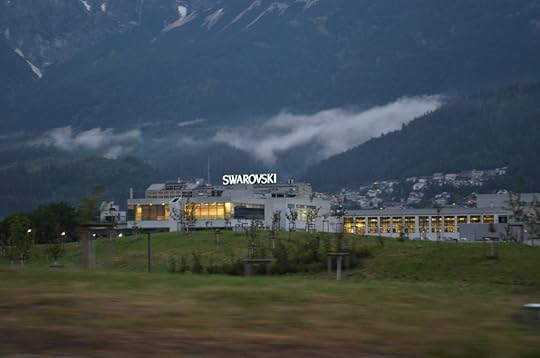
At the base of the Alps in Austria, off a non-descript road that parallels the A4. Who knew? Now you do!
Continuing on are dozens of bike manufacturers and other sporting retail brands we’d no idea were located within driving distance of Innsbruck and a few hours from Salzburg. If I spent much time in the area, I might have definite spending issues, so it was just as well the drive-through was short and it was past closing time for many of the facilities.
The Tyrolean Alps
Part of the fun on this stretch of the journey was going up and over the Tyrolean Alps and the associated small towns. Just on the other side of Innsbruck is Igls, overlooking the city and valley. Just five km outside the city edge, it has a handful of restaurants, a few massive homes, two grocery stores and a church, all within walking distance of several small hotels. We tried to get in for dinner but alas, it was a Friday and all the eateries were booked until closing. Next time!

It’s not always easy to capture the majesty of looming rock formations, but as a visitor, it’s hard not to take yet another snap when the rock faces, type and coloring change within a few miles of one another.
Our biggest mistake of the drive between countries was misjudging the closing of restaurants because each country is so different, we’ve had to remember or learn for the first time. Whereas Italians eat all day and late into the night, the Austrians shut down by 6 p.m. for grocery stores and eight-thirty for restaurants, unless the establishment is a bar or takes restaurants. Back in Hungary, it was late again but Germany and Switzerland were on the early side.

Right outside Igls is Patsch, and it was here we saw our one and only Polizei (police) car in Austria. A mini-mini van stuffed with six officers in uniform, who we later passed by as they ate outside a deli.
That meant we…yes! Stopped again at a McDonald’s café, where the girls have continued their love affair with ham and cheese fries, croissants and hamburgers made with organic meats. I tell myself we didn’t really come to Europe to eat at McDonald’s, but I’m not being fasicious when I claim their food here is an improvement on most restaurant food in the U.S. It’s all about the requirements for fresh and organic, two elements demanded by the Europeans.

The one and only church we saw in Igls, where members of the congregation were streaming out in the misty-rain after a session.
Feature image: a picture of the Swarovski jewel in front of the corporate headquarters.
July 14, 2019
The many faces of Venice
Our adventure to Venice was planned with the intent of determining how much more existed to this famed city other than the Grand Canal and island hopping to Murano. Because of my stint in the Verona Hospital and recovery time, our schedule was cut radically short, so we knew going in this was going to be fast and furious. We needed focus. We needed energy and we needed good walking shoes!
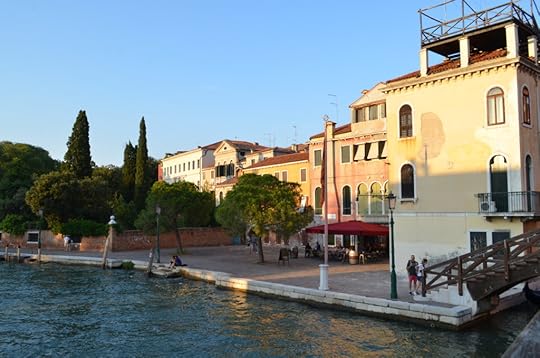
One view from the top of the first canal as you leave either parking, train or cab drop off
Arrival and parking
If you arrive between 11 and 3, you are unlikely to get parking in the main drop off area, so be safe, park, and walk the quarter mile over the bridge into Venice. If you arrive late afternoon, then you’ll likely get parking right in the center, which is what we did. Two structures exist: one for short term (2 hours) and the other for long term. A single lane road is the only way to access both, but it’s short, about one feet in length. It’s a bit of a bottleneck, but an attendant stands to guide traffic, and if you want the two-hour, zip right and you are in. Payment is made when you leave, at the counter located at the entrance, so take your ticket and go on your way.

Nary a gondola or waterway taxi to be seen, and this is about two canals away from the drop off point.
When you arrive in Venice, either by car, train or boat, it may take a moment to notice the absence of bikes, a common site around Europe, not just Italy. In Venice, two-wheeled vehicles aren’t allowed, nor cars, which must be parked in one of several structures either outside the primary bridge to the island. Once off the long bridge to Venice, you will see a multi-story building, and parking spaces are identified by a space counter. We head others complaining about the lack of transportation on Venice, evidently expecting bike or scooter rentals and/or cabs, so I thought to write a note about this for the uninitiated.

This is actually the best shot of “the first” canal bridge in the upper right–you can see it leads several directions, and then down on lanes on either side of the canal proper.
Train
The train service is crazy good, although we didn’t need to take it. Multiple trains coming and going drop and pick up throughout the day, directly to this main area, where people in streams unload. One aspect that’s nice (and little known) is the cruise ships are on the other side of Venice, unloading at the docks. This means those arrive by car or train enjoy a much less crowded experience and more leisurely pace than the hoards of cruise lines passengers. The downside (isn’t there always a downside) is those of us in this area must walk a greater distance to reach the Grand Canal, if that’s the ultimate destination.

Less than 5 minutes from the cab and train drop off is this one and only gondola offering in this area. At 6 at night, it’s walk right up and in.
Walking the blocks
If you want to start off with a gondola ride, it’s less than five minutes from either the parking or train station right down to the only gondola. It has two slots, but when people are waiting, gondolas seemed to magically appear, leading us to believe a radio operator is ever ready to call in reinforcements. If a water tour is more to your liking, you will have to search elsewhere, for while many go by, the pickup/dropoff points aren’t in this zone.

To the right is right where you walk after parking/taxi or train drop off. Across the water are tables filled with evening diners. Not all streets have cafes next to the water–only some, and why the reasoning is a mystery.
With our feet as our guide, we started from the parking station to the first intersection of two canal bridges and a canal pathway. Our first stop was gelato, a must-have on a journey. One block down, another canal, turned left (because we could) and continued forth, zigging and zagging down every alley and main street, up and over a multitude of canal bridges. Going back to the no-bikes rule, even if they were allowed, bikes wouldn’t be much use: the bridges are steps, not smooth surfaces like Chioggia. Food services and goods deliveries are all done by ferry, mostly in the middle of the night and early morning when the tourists have long gone.

One block in, and on the right is a regular lane with more cafes. What you don’t see (or hear) was a man singing Italian tunes and playing a guitar rather romantically.

Another eatery partially hidden behind a iron gate, but open to the public.
Gyms and graffiti
Where do you walk down a canal, under the red brick archways into an open-door gym? Venice, obviously. And any respectable gym must have hip hop music blasting in order to use the weights and cardio machines located five feet from the front desk. It didn’t hurt the visual that the setting sun made the entire street and canal an orange red. In fact, it blended right in with the coloring within the gym itself.

Ok, really? Have you ever seen a blog on Venice post a picture of a gym? Neither had I, so this is it, and a rather glamorous looking one at that, don’t you think? And yes, about a half dozen folks were working out.
Around another corner and through an incredibly narrow street, the avenue opened into a triangular shape and a soccer ball came hurling towards my legs. A boy darted in front of me, kicked the back to his friend, the impromptu soccer game between four youth between ten and twelve seemed strange until I looked up and around. The buildings were decidedly familial, bars and crusted paint falling off and mail-slips. It was a neighborhood, like any other, except on a world-famous island in Italy.
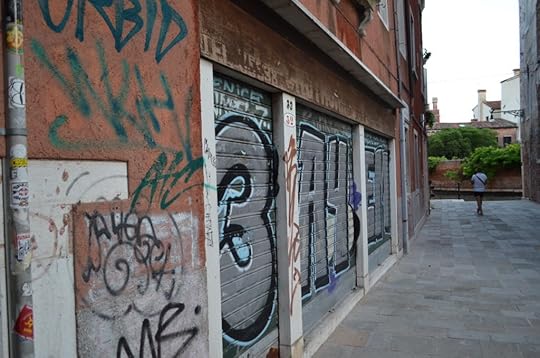
And this! It shocked me more than the gym, because people want to look good, but the city fathers can’t take the time to remove graffiti, and worse, people desecrate the area? I’m all for artistic murals, but this doesn’t qualify.
As we continued the journey, a single avenue changed the entire experience: backstreet soccer game, graffiti-covered metal grates then a beautiful canal with upscale restaurants, then and open square full of hipsters and chill out music and back again. All this still a half a mile away from the Grand Canal main drag, and nary a non-Italian in view (except us). Because we arrived at about 6 p.m., our day spent in Chioggia to the south, the freedom of movement allowed us to cover a lot more ground had it been wall-to-wall tourists.

Think of this as the Venice outskirts, still good real estate with boats outfront but perhaps without the murals on the ceilings.
Just like every other big city
Where one lane is merchants, another is residences, some grand, but most not. Short, narrow doors are not images of Venice blasted around the world. If you’d not been to Venice before, it would be natural to believe every home is a three-story villa with hand-painted mosaics on the ceiling with gold leaf encrusted chandeliers. We watched a woman holding a bag full of groceries pull out her key, open and enter an unassuming door, her attire professional attire resembling a bank teller or shop keeper.
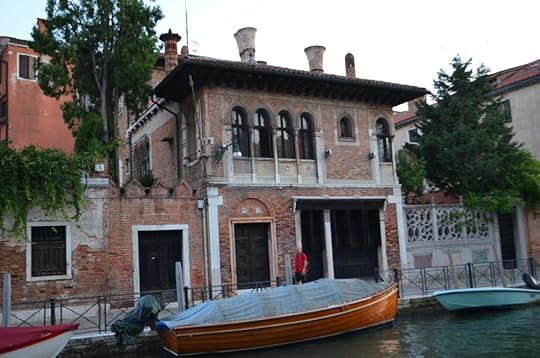
Like any city, different canals showcase a different style of property, probably reflective of the value.
Where in the world was the grocery store? I wondered, becoming completely distracted by the visual of how many canals she had to cross with that single bag. Second to that was imaging the size of the biceps on the average Venician residents. Yes, that’s the kind of thing an author thinks about, or at least, what this author thinks about.

The canal neighborhood where the kids were playing soccer.
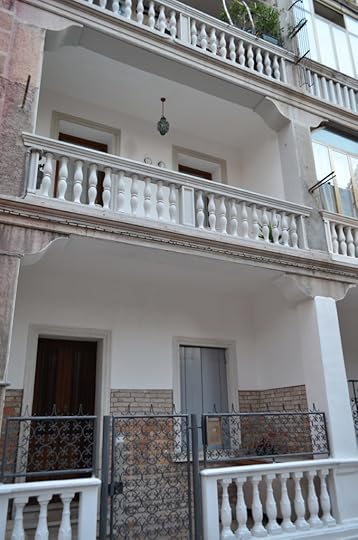
Another home where we saw professionals entering and exiting.
This leads to touch on the subject of shopping. Whereas Chioggia had Italian brands with a smattering of name brands, Venice is the opposite: the majority of mercantile are well-known by the average consumer. Of the little overlap I saw, Venice easily had a 40% premium over Chioggia.

Just one street over is shopping and wide lanes, hotels and eateries.
The take away
If you have the time to take in the famous and not-so-famous areas of Venice, definitely do it, otherwise, it’s like thinking all of New York is Broadway, when in fact you have Central Park, Brooklyn and Park Avenue, each one providing a completing different perspective of a grand city. Whereas Chioggia was all Italians, (we didn’t hear another language spoken) Venice was the exact opposite. The streets were packed full of diverse ethnicities and languages with helpful tour guides translating, many also wearing translating devices around their necks.

I’d like to see those well-fed Merchants of Venice squish themselves down this lane.
Unless you are coming in from a boat, the ideal day trip is the morning for Chioggia and afternoon for Venice, thereby missing the worst of the crowds. You’ll be able to compare and contrast your impressions of the most famous seaside town in Italy, and perhaps the least, all in the same paragraph.

Not the Grand Canal, but a regular office buildings where staff park their boats on the water. It gives new meaning to the phrase underground parking.
Feature photo: a typical side canal in Venice.
July 13, 2019
Chioggia: the “local’s” Venice you shouldn’t miss
When the architect and owner of the villa you have rented in
Verona says you must visit Chioggia instead of Venice, you listen. First in
disbelief (we’d never heard of it), then skepticism (until his architect wife
chimes in, agreeing), and finally with an open mind and consideration.
“It’s only forty minutes south of Venice,” Stefano explained,
“you must go.” As if sensing our reticence, he and his wife peppered us with
the reasons. “It’s older than Venice,” he started. “And it’s a fishing village
with real, working people.” Stefano added that Chioggia has the longest beach
in Italy, better food and is far cheaper.
“It has the oldest clock in the world,” added his wife. “You
will have a much better time in Chioggia. Trust us.”
The oldest clock in world, and in a town we’d never heard of? That sealed the deal.
Off to Chioggia
From Verona, Chioggia is about an hour and forty-five minutes. Long, flat marshes on either side of the low-lying bridge extend until it hit landmass. Coming off the ramp, the first images were…unexpected. Faded paint blended with clothes hanging on windowsills, the boats in the canals long past their prime, fish netting along the sides of the marina.
The main road off the freeway starts to resemble Venice a teeny bit more, only by virtue of the color of buildings, but the style, age and use dramatically differ.
Two rights and we were crossing the first canal bridge. While we’d heard all Stefano and his wife had said regarding an older Venice, we were still expecting….an older Venice.

One of the first views of Chioggia off the freeway. Unexpected, to be sure.
Chioggia is in no way an “older Venice,” if looks meant anything. The buildings aren’t newly painted and bright, but worn with age. Instead of canal boats with a black and white stripe-shirted rower, it’s ocean vessels worthy of a sea storm. The clothes don’t hang just from the window, but lines over the alleyways as well. If you’ve been to Venice, most of what visitors see is bright, perfectly painted and ready for the tourist. It’s only when you get off-off the main drags that you see graffiti (absent in Chioggia) but the homes are still a cosmetic upgrade from Chioggia.

Yes, Chioggia has canals, but it is a regular city as well as you can see.
Then we began to see the other side. Parking was free and plentiful right in the heart of town, exactly twenty feet from the oldest clock in the world. (Venice requires one to park, then walk). Across from the clock, stretching to the water and a mile in the other direction is what Italians call a Piazza- a shopping district. Like Bellagio, outdoor tables, under extended awnings lined the length of the Piazza. The shops are directly behind, the sidewalk totally covered in shade to allow a leisurely shopping experience. Bikes are welcome (not so in Bellagio) and the canals bridges are angled (not with steps, as with Venice) which allows for bikes.
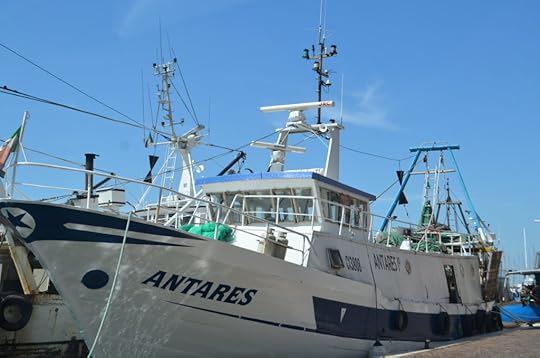
Does this resemble a gondola from Venice to you? It’s so Seattle, I loved it.
The differences in the two towns were becoming apparent.

The world’s oldest clock and two girls from Coeur d’Alene, Idaho.
Clock admired, photos taken and education gained as we learned a replica of the internal mechanisms are in the museum in Verona, but the clock itself is going like a champ.

Not the Grand Canal of Venice, but the intimate, working canal of Chioggia
Time to explore
As we walked, we waited for the beautiful canals full of tourist-filled boats to appear. Nope. Not a one. The canals of Chioggia are not what I’d describe as pretty. They are a bit murky and green. It’s the ocean, seaweed exists and this is a living system, not contrived into a fantasy environment. Bikers rode up and over the canals, fishermen trolled their boats out to sea, and as the sun set, the villagers living in the town began to come out of the homes.

Buildings are further apart, some canals have been modified and the styles are old and new, just like any modern city.
Watching the activity was like going on a first date with a short individual dressed in their parent’s hand-me-downs who was late for the date, only to notice the smooth skin of the face, bright, blue eyes and happy, embracing laugh.
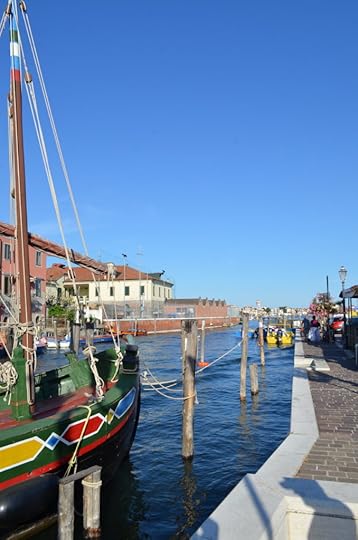
Another working waterway heading to the ocean.
Along a side street, my girls spotted what turned out to be a couture children’s clothing shop at Target prices. We spent about 150 Euros on clothes that would have cost two grand in the States, if we’d been able to find them at all. More shopping followed until we joined a growing number of seniors taking places under the awnings. The crowd was a wonderfully mixed bag of what Dominic Dunn would have called “mature women” in full makeup and big, black and gaudy glasses sitting beside others who embraced their natural, wrinkly selves. They talked as much with their hands as mouths as their husbands in press shirts smoked, making way for continual additions to the group.

A young man, about 14, coming in from a ride, giving it all he can. Not something you’d see in “that other city with the canals.”
It’s not always easy to take photos of strangers, and sometimes, I prefer to sit back and observe, which I did, requiring to you visualize the experience. Yet as I removed my camera to take images of the food, I sensed a weirdness and looked up. Sure enough, a woman, leaning out her window was observing us. It had become a common sight across Italy; an open window with a look-e-loo taking in the scene. Of that, I did take a photo.

The Italian pastime — looking out the window to the piazza below.
A meal worth driving 90 minutes
The Sugar Cafe
Caught that morning, Rog ate a half dozen whole mini octopus, heads still on. It was mixed in his seafood salad, a sight my father would have crawled over shards of glass to sample. The girls had pasta dishes and Rog also ordered a fish carpaccio, which he’d never had before. Different from sushi, the white fish (we never did learn the name), Rog announced the platter size portion to be heaven on earth and consumed the entire thing himself.



Fresh and delightful– caprese (UL), fish tartare (UR) and seafood salad.
Dessert followed on a side-street, everyone having double
helpings of gelato in different flavors. By this, our fourth day in Italy, the
girls had a fair idea of approximately size and cost. Imagine their delight
when the portions were about half again as large, and roughly a third the price
of Verona, Soave or San Briccio.
What had evolved from an unexpectedly good first date was now an engagement-level passion with the town of Chioggia.

At the Sugar Café–note all the older folks closest to the storefronts–little groups of 3-5, all gathering, community style for their evening dinnertime social.
The famed beaches
Famous to who? We wondered as we drove the mile from our eatery towards the coastline. As you can see from the pictures, famous to the rest of the world of Italians, not to visitors such as ourselves. From one end to the other, thousands of umbrellas await the flock of crowds expected to descend in the next week as school gets out, then absolute mayhem in August. As we drove along the beachfront, we wondered about parking. While the streets were empty of cars at this time of year, and the inside/beach area parking also practically vacant, it wasn’t hard to image the brutality of high season. For grins, we checked out the parking fees, recalling how the last parking fee we’d paid in downtown Seattle was $12 US for an hour, this had to be comparative, or so we thought. Two hours here on the beach, roadside and 100 feet away is 4.50 Euro. No wonder the Italians in Verona love this town.

The beaches of Chioggia. I had no idea it was Miami, Italian-style. Although, I haven’t seen hundreds of cabanas, umbrellas pools like this in Florida.
We’d fallen in love with Chioggia, and didn’t even know it. As a family, we agreed to go back the following day, conduct more serious shopping and eating, which ultimately, didn’t happen. We all overslept, because we darted up to Venice to catch the setting sun and wander for a few hours. You can compare the two cities by reading the blog on the experience.
Recommendation
Definitely take the few hours to enjoy this essentially unheard of, overlooked and /or ignored town. It will open your eyes to a different side of the Italian world, one truly authentic and in its own way, inspiring and charming.
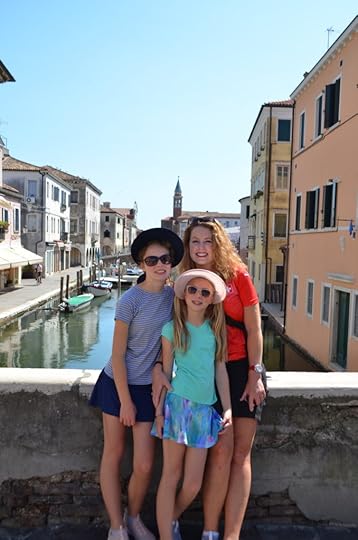
Feature photo: the canals of Chioggia
Locanda ai Capitelli: the best dining in Verona
Two days after the hospital experience, we were up at Soave Castle, finishing up as the rainstorm passed us by. On the way down, we decided to purposefully get lost among the vineyards, driving up and down the roads just to see what’s around the next corner. We were only a few miles into this journey when we spotted a grand building to our right, overlooking three vineyards. The cars lining both sides of the streets was a good sign and we stopped so Rog could jump out and look at the menu. He returned, crestfallen.
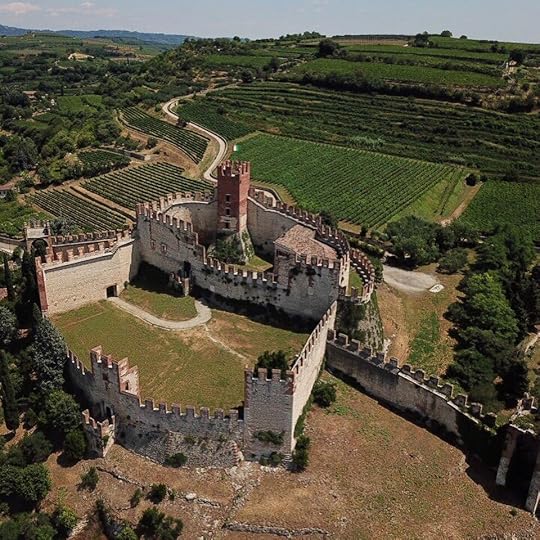
Locanda ai Capitelli is located just to the lower left of this photo–but hadn’t found it when we took the drone shot:(
“They have steak tartar, but we aren’t dressed for it.” I
looked past him to the elegant stairway and sure enough, the men were in slacks
and button-down shirts. It was a stark contrast to his shorts and golf shirt,
and our female attire of shorts and light shirts made for sweating, not dining.
“Just go in and ask,” encouraged Porsche, our thirteen-year-old.
“It’s Italy.” I had to agree with her, but Rog wasn’t going to bother. He put
it in gear and off we went, for about a mile.
“I just have to do it,” he said with resolve, turning around.
Back we went, and sure enough, he came out smiling. “She said ‘of course!’”
Casual elegance without pretension
It turns out the establishment of Locanda ai Capitelli is a bed and breakfast, not just an elegant restaurant. Once inside, we realized the only other diners were in a private room, the main area, about thirty by fifteen in length, was empty.

Perfectly situated on the corner of Castle and wine country is
Locanda ai Capitelli
“It’s early,” I said under my breath. At seven-thirty, it
shouldn’t have been a surprise. Dining in Italy starts about eight-thirty, when
the heat has waned, showers have been taken and the second part of day begins.
Because of this, we had the undivided attention of the waiter and hostess, Julia, who is the daughter of family/owners of the B & B. A slip of a young woman, sophisticated casual in a black t-shirt and pencil shirt with high-top Converse shoes, Julia is about as millennial as one could be. Perfect command of the language, helpful and happy, yet able to handle even the pickiest of diners who started to come in as we were half-way through our appetizers.
The best meal in Italy—so far
Even though I couldn’t eat much, I tried a bit of every dish. The octopus in cream sauce sounded completely odd, but I ordered it anyway, along with the carpaccio. We also decided upon the black truffle linguini with clams, another of the same without the clams, a chicken dish, Roger’s steak tartar and I asked for the gnocchi with peas and trout. Weird, I know, but it was calling my name.

Octopus in cream sauce. One bite was all it took for us to agree it was the best we’d ever had, and that’s saying something.
“Just a bite,” I promised Rog.
As each plate arrived, Julia described the cows on the family farm from whence her mother and grandmother made the ricotta and parmesan cheeses, the desserts and cream sauces. The pigs down the road supplied the prosciutto, and the farm in back were to thank for the herbs and spices. When she’d gone, Rog quipped the very porcelain plates and silverware were probably forged in the basement. I’m not a food critic, and worry my descriptions won’t do the cuisine justice. Suffice it to say we loved every dish, wishing we had the stomachs to order more. I will note my freshly-made gnocchi was the best I’ve ever eaten, the trout was perfectly cooked in little bits, set off with the light, white cream and sweet peas. I wanted to lick the plate, but had to suffice with my spoon due to the recent stomach issues.

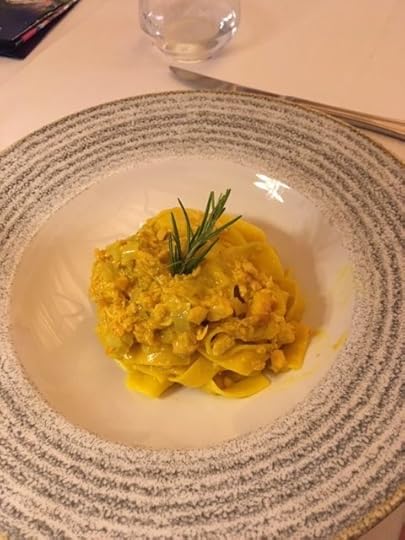

Gnocchi with trout and peas (UL) chicken fettuccini (UR) and steak tartar. Exquisite.
By the time we reached dessert, being hungry wasn’t the consideration. The family just couldn’t stop. We had a dessert sampler plate, along with the tiramisu. Now, I don’t get violent often, but when someone attempts to snack on my dessert, I’ve been known to stab with my knife, not enough to blood, but to warn the offending party off.
This time around, my inability to do more than taste undoubtedly prevented blood from being spilled, but it surely would have under different circumstances. The tiramisu was creamy, sweet but not overly so. I could wax philosophic but won’t.

Clean elegance in the wine country. Not pictured is a private dining room to the left of the entrance (where the man is standing).
Our meal was so decadent, the atmosphere elegant but not stuffy, Rog just had to inquired about the rates. 90 Euro a night for a room with accommodations for two. Imagine that: a room with a view overlooking the wine fields of Verona in front and to either side, the Castle Soave in the upper left, and a five-star restaurant below (the Gerdes rating system).

That’s a whole lotta love and cream poured into this tiramisu. Divine.
A family affair
When we paid the bill, the dining room was full and Julia joked about opening a restaurant in the States. “Sure,” Rog readily agreed. “As long as we can bring you, your mother and grandmother over to run it.” That led to me to ask if I could take a picture with my new friend. At the foyer, she met us with her mother.
“Grandmother is already in bed,” Julia explained apologetically. Kisses and hugs were forthcoming, the warmth of a family who put their life and love into their food and accommodations enveloping us.

The females of the gang, moms and daughters alike (Julia to my right)
Recommendation
If you’re already going to Verona, you must add Locanda ai Capitelli to the list. While I can’t speak to the accommodations, I will tell you it’s on our list for the next trip. When you arrive, give a special hug of love to Julia and her mother for us, and order the gnocchi and tiramisu. Well, order it all, because if you don’t, you will wish you had.



